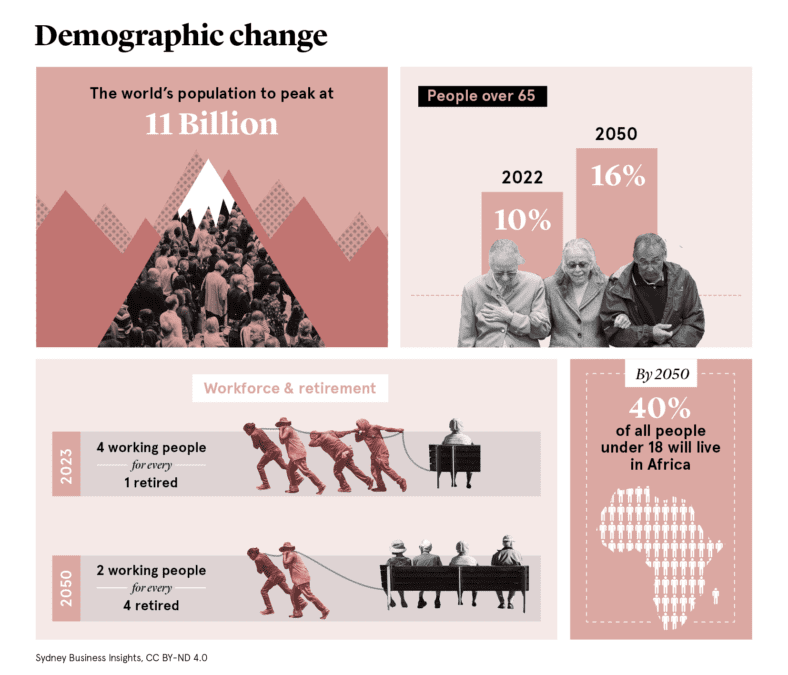人口结构的变化
经过200多年的快速增长,世界人口将在本世纪末达到110亿的峰值。
人们生的孩子越来越少,寿命越来越长。
这是人口结构变化的大趋势——一种深刻的人口变化,将影响个人、家庭和社区。
65岁以上人口的比例将从2022年的10%增长到2050年的16%。
随着人口老龄化,将会有更少的工作人口来支持越来越多的退休人口。
今天,每一个老年人对应着四个处于工作年龄的人。到2050年,预计将只有两个工作年龄的人支持四个老年人。
大约40个国家——包括日本、意大利和波兰——已经在经历人口下降。
中国人口在经历了60年的增长后,于2022年开始收缩,这是一个重大转折点。
到2050年,至少还有88个国家将进入人口收缩。
然而,在世界某些地区,人口趋势正反其道而行之。到本世纪中叶,撒哈拉以南非洲的人口将增加近一倍,超过20亿,到2070年,该地区将超过亚洲,成为地球上人口最多的地区。印度、巴基斯坦和菲律宾等国家的人口也将继续增长。
到2050年,世界总人口的25%,以及40%的18岁以下人口将生活在非洲。
非洲大陆及其活跃的人口增长将带来新的贸易和发展机会,加速经济力量的转移。
对于全球其他地区来说,这种前所未有的老龄化将需要相当大的调整和应对。移民将成为大多数高收入国家人口增长的唯一推动力。
在产品和服务方面,特别是在卫生和住房,将有持续创新的空间。
如果各国要提高生产率并解决劳动力短缺问题,就必须为传统边缘化群体提供灵活就业机会,并使劳动力更具多样性和包容性,再培训和技能提升也至关重要。
如果我们想在21世纪蓬勃发展,了解并应对各地不同的人口压力将至关重要。
Bloom, D.E., Zucker, L.M. (2022). ‘Aging is the Real Population Bomb’, IMF Finance & Development. Available at: https://www.imf.org/en/Publications/fandd/issues/Series/Analytical-Series/aging-is-the-real-population-bomb-bloom-zucker
Alvarez, P. (2022). ‘What does the global decline of the fertility rate look like?’, Ageing and Longevity, World Economic Forum. Available at: https://www.weforum.org/agenda/2022/06/global-decline-of-fertility-rates-visualised/
Our World in Data (2022). ‘Median Age, 1950-2100’. Available at: https://ourworldindata.org/grapher/median-age?tab=chart&year=2020&time=1950..2100&country=OWID_WRL
World Population Review (2023). ‘Countries with Declining Population 2023’. Available at:
https://worldpopulationreview.com/country-rankings/countries-with-declining-population
Selassie, A. (2021). ‘The African Century’, IMF Finance and Development. Available at:
https://www.imf.org/en/Publications/fandd/issues/2021/12/African-Century-Abebe-Selassie
United Nations’ Department of Economic and Social Affairs, Population Division (2022). World Population Prospects 2022: Summary of Results. Available at: https://www.un.org/development/desa/pd/sites/www.un.org.development.desa.pd/files/undesa_pd_2022_wpp_key-messages.pdf
United Nations’ Department of Economic and Social Affairs, Population Division (2022). World Population Prospects 2022.Available at:
https://population.un.org/wpp/
UNICEF Data (2017). Generation 2030 Africa 2.0. Available at:
https://data.unicef.org/resources/generation-2030-africa-2-0/
French, H.W. (2022). ‘Megalopolis: how coastal west Africa will shape the coming century’, The Guardian 27/10/22. Available at: https://www.theguardian.com/world/2022/oct/27/megalopolis-how-coastal-west-africa-will-shape-the-coming-century

We believe in open and honest access to knowledge. We use a Creative Commons Attribution NoDerivatives licence for our articles and podcasts, so you can republish them for free, online or in print.
Archive

Confronting ageing: the talk Australia has to have
Australian society will be reshaped as its population ages, it needs to have some confronting conversations about ageing and how it pays the inevitable cost.

Black learning matters – appreciating Indigenous wisdom in management education
How can educators respectfully and meaningfully introduce Indigenous stewardship concepts with a sense of appreciation rather than appropriation?

The demographic change of the century
This century’s shifting population patterns are the fuel that will power significant economic change.

Looking for employees with high productivity and low turnover? Hire a refugee.
Research shows refugees make motivated, loyal employees with lower turnover, but are employers overlooking this untapped talent due to assumptions and perceived barriers?

There is a SMART solution to worker burnout
The psychological toll on healthcare and social assistance workers is immense - what if we could reimagine these jobs to prevent burnout?

India’s population overtakes China
Two traditional societies must both confront the need to reformulate social norms as their populations change.

Leading women into digital careers – programming not required
For International Girls in ICT Day, we reflect on a recent Women Leading in Digital event.

Getting old means never getting to retire
Demographic time-bombs and super ageing societies - what does it all mean for countries with falling birth rates?





